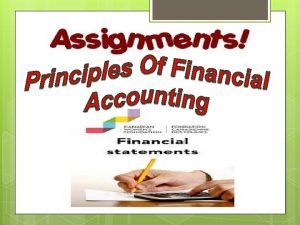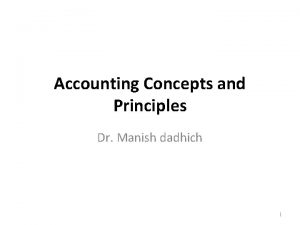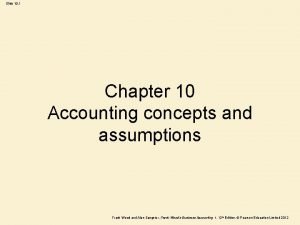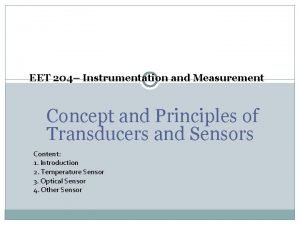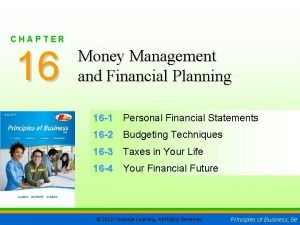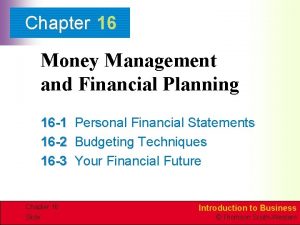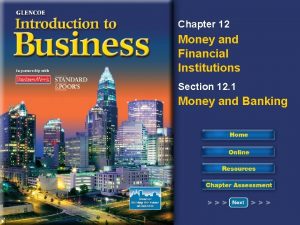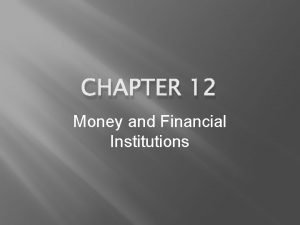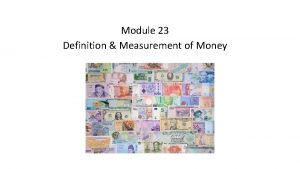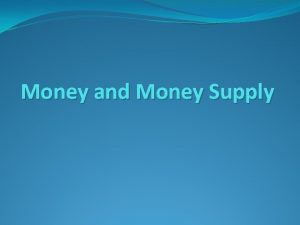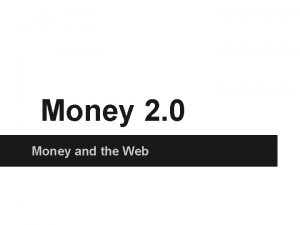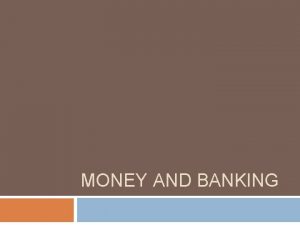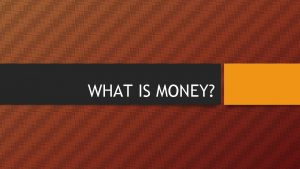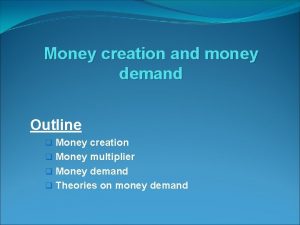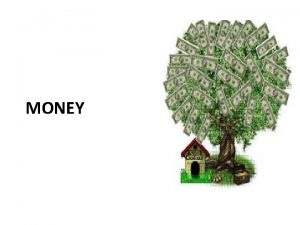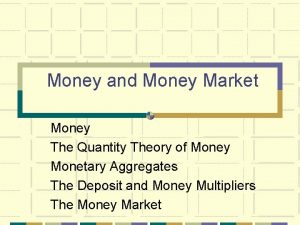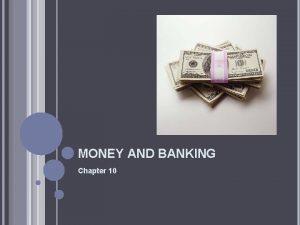Financial Sector Definition and Measurement of Money AP















- Slides: 15

Financial Sector: Definition and Measurement of Money AP Economics Mr. Bordelon

You’re so money, baby, and you don’t even know it! • Money. Any asset that can easily be used to purchase g/s. Money eliminates the need for bartering. • But what’s the point of money? Money serves certain roles: ▫ Medium of exchange ▫ Store of value ▫ Unit of account

Roles of Money • Medium of exchange. Asset that individuals acquire for the purpose of trading g/s rather than for their own consumption. ▫ Accepting currency as a medium of exchange eliminates the need for barter. ▫ If our currency was chicken, you’d have to buy a cup of coffee with a chicken. Chickens are inconvenient to carry around. A dollar on the other hand, is much easier, cleaner, and less likely to give you bird flu.

Roles of Money • Store of value. Means of holding purchasing power over time. ▫ If chickens are currency, it’s kind of hard to tell whether one chicken is actually one chicken from one day to the next. Chickens lose and gain feathers. Chickens die. Chickens aren’t smart, they thought they could fly, but chickens couldn’t fly, they DIE. They’re the chickens who DIE! ▫ But it’s a good bet that $1 bill will equal $1 yesterday, tomorrow, and in the future, at least conceptually. It’s durable, divisible, and lacks chicken blood.

Roles of Money • Unit of account. Measured used to set prices and make economic calculations. ▫ We’re not only talking the numerical value here, but also the actual unit of currency: dollars, pounds, euros, etc. ▫ Sorry, I’m out of chicken jokes. Except that it’s tough to make change out of a chicken, and eggs don’t count.

Types of Money • Commodity money. Good used as a medium of exchange that has intrinsic value in other uses. In other words, the commodity that the money is made from is worth something in and of itself. ▫ Gold, silver, copper typically have been the commodities used. ▫ Generally, a bad idea. If the commodity is worth more than the currency, people will take the commodity instead of the cash, and melt it down. This takes money out of circulation.

Types of Money • Commodity-backed money. Medium of exchange with no intrinsic value whose ultimate value is guaranteed by a promise that it can be converted into valuable goods. ▫ Commodities have value. What if you could create a dollar bill whose worth is based on gold? That’s the idea of commodity-backed money. Once upon a time, you could actually exchange the dollar for it’s amount in gold. ▫ Problem is if the commodity loses value, so does the money. And this is what happened in the stock market crash of 1929. Once gold lost its value, so did the U. S. dollar.

Types of Money • Fiat money. Medium of exchange whose value derives entirely from its official status as a means of payment. ▫ In this case, money is money because the government says it is. This is the basis for the modern financial system. It’s based on the sovereign right of seigneurage, the right to coin money.

Types of Money • Special note on fiat money. Fiat money is the way money is made today, because the U. S. government says so, and the full faith and credit of the U. S. government, through its central bank of the Federal Reserve is enough. • We are NOT on the gold standard. I will raise hell upon high, I will make the seas boil, the earth quake, and unleash plagues upon your ancestors and all the earth, the eighth seal will be broken and there will be a silence in heaven for about 30 seconds if ANY OF YOU ever state that we are. ▫ Grrrr.

How Much Money is Out There? • You can measure money. • Rephrase: You must be able to measure the money supply in order to pass the AP Macroeconomics exam. • Monetary aggregate. Overall measure of the money supply. • Two measurements: M 1 and M 2.

M 1 • M 1 is a measurement of liquidity. M 1 is limited to ▫ Currency in circulation ▫ Checking accounts ▫ Traveler’s checks

M 2 • M 2 is a measurement that includes liquidity and near moneys (assets that can’t be directly used as a medium of exchange but can be converted into cash/checking deposits). ▫ ▫ M 1 Savings accounts Money market accounts Certificates of Deposits (CDs)

Question 1 For each of the following transactions, what is the initial effect (increase or decrease) on M 1? Or M 2? • You sell a few shares of stock and put the proceeds into your savings account. • You sell a few shares of stock and put the proceeds into your checking account. • You transfer money from your savings account to your checking account. • You discover $0. 25 under the floor mat in your car and deposit it in your checking account. • You discover $0. 25 under the floor mat in your car and you deposit in your savings account.

Question 2 There are three types of money: commodity money, commodity-backed money, and fiat money. Which type of money is used in each of the following situations? • Bottles of rum were used to pay for goods in colonial Australia. • Salt was used in many European countries as a medium of exchange. • For a brief time, Germany used paper money (the “Rye Mark”) that could be redeemed for a certain amount of rye, a type of grain. • The town of Ithaca, New York, prints its own currency, Ithaca HOURS, which can be used to purchase local goods and services.

Question 3 • Indicate whether each of the following is part of M 1, M 2, or neither: ▫ ▫ ▫ $95 on your campus meal card $0. 55 in the change cup of your car $1, 663 in your savings account $459 in your checking account 100 shares of stock worth $4, 000 A $1, 000 line of credit on your Sears credit card
 Dana damian
Dana damian Financial sector definition
Financial sector definition Going concern entity concept
Going concern entity concept Boundary rules in accounting
Boundary rules in accounting Explain money measurement concept
Explain money measurement concept 10 concepts of accounting
10 concepts of accounting What is money measurement concept
What is money measurement concept Motifs in the great gatsby
Motifs in the great gatsby Money smart money match
Money smart money match Money on money multiple
Money on money multiple Old money vs new money
Old money vs new money Context of the great gatsby
Context of the great gatsby Chapter 16 money management and financial planning
Chapter 16 money management and financial planning Chapter 16 money management and financial planning
Chapter 16 money management and financial planning Chapter 12 money and financial institutions
Chapter 12 money and financial institutions Chapter 12 money and financial institutions
Chapter 12 money and financial institutions


